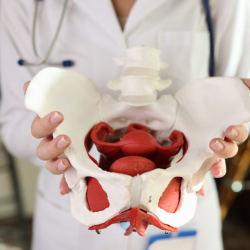
The pelvic floor is a group of muscles that play an essential role in bladder control and managing urinary incontinence. When these muscles weaken, whether due to age, pregnancy, or other factors, it can lead to urinary incontinence and reduced quality of life. This post explains the importance of pelvic floor health, the impact it has on bladder control, and effective ways to strengthen these muscles to manage and prevent incontinence.
What is the Pelvic Floor?
The pelvic floor muscles form a sling across the base of the pelvis, supporting key organs such as the bladder, bowels, and, in women, the uterus. These muscles contract and relax to allow for bladder and bowel control and play a crucial role in overall pelvic health. Weakness or damage to these muscles often leads to bladder control issues and can cause different types of incontinence.
Why Pelvic Floor Health Matters for Incontinence
Supports Bladder Control
A strong pelvic floor acts as a support system for the bladder. When these muscles weaken, it can lead to urinary leakage during everyday activities like sneezing, laughing, or exercising, a condition known as stress incontinence.
Improves Core Stability
Core stability is often associated with fitness and back support, but the pelvic floor is a key component of a strong core. Strengthening these muscles not only helps prevent incontinence but also enhances physical stability.
Reduces Symptoms of Urge Incontinence
For those experiencing urge incontinence, the ability to control the bladder becomes crucial. A healthy pelvic floor allows for better control over the bladder muscles, helping to manage sudden urges to urinate.
Prevents Future Weakness
Over time, the pelvic floor naturally weakens, especially for women who have gone through pregnancy or menopause. Proactively strengthening these muscles can help maintain bladder health and prevent future incontinence.

Tips for Strengthening Your Pelvic Floor
Strengthening the pelvic floor is achievable with simple exercises and new, innovative treatments. Here are effective ways to regain control:
Pelvic Floor Exercises (Kegels)
Kegels are exercises that involve repeatedly contracting and relaxing the pelvic floor muscles. Performing these exercises regularly helps build strength and resilience in the pelvic muscles. Kegels can be done discreetly and are effective in managing incontinence when done consistently.
Lifestyle Adjustments
Adopting a pelvic floor-friendly lifestyle can also aid in strengthening these muscles. Maintaining a healthy weight, avoiding smoking, and reducing caffeine intake can help reduce bladder pressure and prevent weakening of the pelvic floor.
Non-Invasive Treatments: The Emsella Chair
The Emsella Chair offers a non-surgical, effective way to strengthen the pelvic floor muscles through High-Intensity Focused Electromagnetic (HIFEM) technology. Sitting on the chair triggers thousands of pelvic floor contractions in a single session—far more than can be achieved through exercises alone. This treatment is safe, non-invasive, and requires no downtime.

How the Emsella Chair Helps with Pelvic Floor Health
The Emsella Chair is a revolutionary solution for those seeking to improve their pelvic floor health without invasive procedures. Each session lasts about 30 minutes, allowing clients to stay fully clothed and simply relax as the technology does the work. Over several sessions, many clients report a significant reduction in incontinence symptoms and an improvement in bladder control.
Ready to take control of your pelvic floor health?
The Emsella Chair at Time Hair & Beauty offers a non-invasive, effective treatment to help manage incontinence. Book your consultation with our team today to see how Emsella could benefit you.
